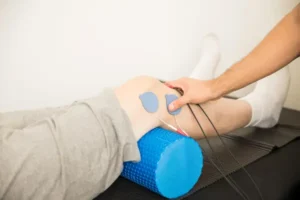The Benefits of Physical Therapy: Discover Best 5 Providers

- What is Physical Therapy?
- The Role of Physical Therapy in Improving Quality of Life
- Benefits of Physical Therapy for Different Conditions
- Physical Therapy Exercises and Techniques
- How to Find the Right Physical Therapist for Your Needs
- Best 5 Physical Therapy Providers in the United States
- The Importance of Consistency in Physical Therapy
- Benefits of Sports Physical Therapy for Athletes
- Physical Therapy for Post-Surgical Recovery
- Conclusion: The Long-Term Benefits of Physical Therapy for Overall Well-being
- Frequently Asked Questions (FAQs)
What is Physical Therapy?
This post may contain affiliate links, meaning I may earn a commission if you make a purchase, at no extra cost to you. I only recommend products I trust. Thank you for your support.
Physical therapy is a specialized form of treatment that helps individuals regain and enhance their physical abilities.
It involves the use of various techniques such as therapeutic exercises, manual therapy, and modalities like heat or electrical stimulation.
The ultimate goal of physical therapy is to improve mobility, reduce pain, and enhance overall physical function.
In this article, we will explore the many benefits of physical therapy, the exercises, reputable providers, and how it can significantly improve your quality of life.
How Much Does Physical Therapy Cost?
On average, a session of physical therapy can range from $50 to $150.
The cost can vary depending on several factors, including the location, duration of treatment, and the specific services required.
However, this cost may be covered partially or fully by health insurance, so it is essential to check with your provider to understand your coverage.
What to Wear to Physical Therapy?
When attending physical therapy sessions, it is crucial to wear comfortable and loose-fitting clothing that allows for easy movement.
Opt for athletic wear or loose clothing that does not restrict your range of motion. Additionally, choose supportive footwear that provides stability and helps prevent slips or falls during exercises.
The Role of Physical Therapy in Improving Quality of Life
Physical therapy plays a vital role in improving the quality of life for individuals of all ages and abilities.

Here are ten key roles of physical therapy:
Pain Management:
- Techniques such as manual therapy, therapeutic exercises, and electrical stimulation can help alleviate pain and discomfort.
Mobility Enhancement:
- Physical therapists focus on improving mobility, balance, and coordination, allowing individuals to move more freely and confidently.
Injury Prevention:
- By identifying and addressing movement dysfunctions and imbalances, physical therapy helps prevent future injuries.
Rehabilitation:
- Physical therapy aids in the recovery and rehabilitation process following surgery, accidents, or injuries.
Falls Prevention:
- Through balance and strength training, it reduces the risk of falls, especially in older adults.
Chronic Disease Management:
- Physical therapy can help manage symptoms and improve function in individuals with chronic conditions such as arthritis or Parkinson’s and Alzheimer’s disease.
Posture Correction:
- Physical therapy techniques and exercises can correct poor posture, leading to improved spinal alignment and reduced pain.
Neurological Rehabilitation:
- Physical therapy is instrumental in rehabilitating individuals with neurological conditions such as stroke or multiple sclerosis.
Respiratory Improvement:
- Physical therapy techniques can enhance lung function and breathing patterns, benefiting individuals with respiratory conditions like asthma.
Enhancing Overall Well-being:
- Physical therapy promotes a sense of well-being by improving physical function, reducing pain, and enhancing overall quality of life.
Benefits of Physical Therapy for Different Conditions
Physical therapy offers a wide range of benefits for various conditions, helping individuals regain strength, mobility, and independence.
Let’s take a closer look at some common conditions and their associated benefits of physical therapy:
Musculoskeletal Conditions:
- Physical therapy is highly effective in treating musculoskeletal conditions such as arthritis, back pain, and joint injuries.
- Through targeted exercise programs, therapists can reduce pain, improve joint mobility, and enhance overall functioning.
Orthopedic Injuries:
- Physical therapists can aid in the recovery and rehabilitation of orthopedic injuries such as fractures, sprains, and strains.
- It helps reduce pain, restore strength and flexibility, and improve overall function.
Sports Injuries:
- For athletes and sports enthusiasts, physical therapy is an integral part of recovery following injuries.
- It focuses on restoring strength, flexibility, and endurance, helping individuals return to their pre-injury level of performance.
Chronic Pain Conditions:
- Individuals suffering from chronic pain conditions like fibromyalgia or lower back pain find relief through physical therapy.
- Techniques such as manual therapy, therapeutic exercises, and modalities help manage pain and improve function.
Neurological Conditions:
- Physical therapy plays a crucial role in the rehabilitation of individuals with neurological conditions like stroke conditions, spinal cord injuries, or multiple sclerosis.
- It helps improve mobility, balance, and coordination.
Cardiac Conditions:
- For individuals with heart conditions, physical therapy provides structured exercise programs that help improve cardiovascular health and endurance.
Pediatric Conditions:
- Children with developmental delays or conditions like cerebral palsy benefit from physical therapy.
- It helps improve motor skills, coordination, and overall physical development.
Geriatric Care Conditions:
- Older adults often face mobility challenges and increased risk of falls.
- Physical therapy can help improve balance, strength, and flexibility, reducing the risk of falls and enhancing overall functional ability, allowing seniors to maintain an active and independent lifestyle.
Physical Therapy Exercises and Techniques
There are a wide range of techniques and exercises to address specific conditions and goals.
Here are some commonly used physical therapy exercise and techniques:
Therapeutic Exercises:
- Therapeutic exercises focus on improving strength, flexibility, and endurance. These exercises can include stretching, resistance training, cardiovascular conditioning, and balance training.
- Therapists customize exercise programs based on individual needs and gradually progress the intensity to achieve optimal results.
Electrotherapy Techniques:

- Electrotherapy utilizes electrical stimulation to target specific muscles or nerves. This technique can help reduce pain, promote muscle strengthening, and improve muscle function.
- Common forms of electrotherapy include transcutaneous electrical nerve stimulation (TENS) and neuromuscular electrical stimulation (NMES).
Strengthening Exercises:

- Strengthening exercises not only promote muscle development but also contribute to better joint stability, increased bone density, and improved overall functional capacity.
- Therapists carefully select exercises based on the patient’s diagnosis and goals. Examples include weightlifting, resistance band exercises, and bodyweight exercises like squats and push-ups.
Balance and Proprioception Training Exercises:
- Balance and proprioception training exercises are crucial for individuals with balance disorders or a high risk of falls.
- Physical therapists use various exercises, such as standing on one leg, walking on uneven surfaces, or using balance boards, to improve stability and body awareness.
Gait Training Exercises:
- Gait training exercises such as heel to toe walking, lunges, and side stepping exercises focus on improving an individual’s walking pattern and overall mobility.
- These exercises encompass a range of activities designed to enhance posture, balance, and coordination, promoting a more efficient and stable gait
Manual Therapy Techniques:
- Manual therapy techniques involve skilled hand movements by therapists to manipulate joints, muscles, and soft tissues.
- These techniques can include massage, hip recovery exercises, joint mobilization, soft tissue mobilization, and myofascial release. which helps to reduce pain, improve joint mobility, and restore normal tissue function.
Aquatic Therapy Techniques:
- Aquatic therapy takes advantage of the buoyancy and resistance provided by water to facilitate rehabilitation.
- This low-impact form of therapy is particularly beneficial for individuals with joint pain, arthritis, or limited weight-bearing ability.
Modalities Techniques:
- Techniques such as heat therapy, cold therapy, electrical stimulation, cryotherapy, needle therapy, and ultrasound therapy are employed to reduce inflammation and promote healing.
- These modalities facilitate tissue repair, decrease swelling, and provide pain relief, contributing to improved mobility.
Physical therapists design individualized treatment plans based on the specific needs and goals of each patient.
How to Find the Right Physical Therapist for Your Needs
When seeking physical therapy services, it is crucial to find the right therapist for your needs.
Here are some tips to help you make the right choice:
Ask for Recommendations:
- Seek referrals from your primary care physician, friends, or family members who have had positive experiences with physical therapists.
Research Credentials:
- Ensure that the physical therapist is licensed and has the appropriate education and certifications.
Therapist Specializations:
- Consider therapists who specialize in your specific condition or area of interest.
Compatibility with Physical Therapist:
- Schedule a consultation or initial session to determine if you feel comfortable and confident in the therapist’s approach.
Insurance Coverage:
- Check if the therapist accepts your insurance or offers affordable payment options.
Finding the right physical therapist ensures that you receive the best possible care and achieve optimal outcomes.
Best 5 Physical Therapy Providers in the United States
When looking for reputable physical therapy providers in the United States, consider the following top providers:
ATI Physical Therapy:
- They are a leading provider with a vast network of clinics across the country.
- They offer comprehensive rehabilitation services, including manual therapy, therapeutic exercises, and specialized programs for various conditions.
Select Physical Therapy:
- They are known for their evidence-based approach, providing specialized care for various conditions.
- Their services include sports rehabilitation, neurological disorders, and musculoskeletal conditions.
Benchmark Physical Therapy:
- They provide evidence-based treatment and personalized care for various conditions.
- They offer services such as aquatic therapy, pediatric therapy, and work-related injury programs.
CORA Physical Therapy:
- CORA offers a wide range of services, including orthopedic therapy, sports medicine, and work injury programs.
- They have numerous locations across the United States.
Pivot Physical Therapy:
- Pivot provides comprehensive care for various conditions, including sports injuries, orthopedic rehabilitation, and women’s health.
- They offer personalized treatment plans and have convenient locations.
These providers offer excellent services and have a reputation for delivering high-quality physical therapy care.
The Importance of Consistency in Physical Therapy
Consistency is crucial to achieve the best results. Consistency helps improve strength, flexibility, and overall function, leading to better long-term outcomes.
To achieve the best outcomes, it’s important to attend scheduled therapy sessions and follow the prescribed home exercise programs.
It is essential to communicate openly with your physical therapist regarding any challenges or concerns you may have.
They can provide guidance, make necessary adjustments to the treatment plan, and motivate you to stay consistent.
Here are the reasons why consistency is key:
Progression of Treatment:
- Consistent attendance allows therapists to monitor progress, adjust treatment plans, and ensure that therapy is appropriately tailored to individual needs.
- Regular sessions help track improvements and make necessary adjustments for optimal results.
Muscle Memory and Skill Acquisition:
- Consistent practice of exercises and techniques helps develop muscle memory and enhances skill acquisition.
- Regular repetition of movements improves coordination, strength, and overall functioning, leading to long-lasting improvements.
Prevention of Relapse:
- Consistent therapy sessions and home exercise programs help prevent relapses and maintain the progress achieved.
- Regular engagement in therapeutic activities strengthens muscles, joints, and tissues, reducing the risk of re-injury or regression.
Motivation and Accountability:
- Consistency fosters motivation and accountability. By adhering to therapy plans, individuals are more likely to stay committed to their recovery journey, leading to better outcomes and improved overall well-being.
Benefits of Sports Physical Therapy for Athletes
Sports physical therapy is a vital component of athlete rehabilitation and injury prevention.
It focuses on restoring strength, flexibility, and endurance while addressing specific sports-related injuries.
Physical therapists work closely with athletes to develop personalized treatment plans and exercise programs that target their specific needs.
Benefits of sports physical therapy for athletes include:
Injury Prevention:
- Physical therapists work with athletes to develop exercise programs that focus on injury prevention.
- These programs include flexibility training, strength conditioning, and sport-specific exercises to enhance performance and reduce the risk of injuries.
Rehabilitation:
- In the event of an injury, physical therapy facilitates a safe and effective recovery, therapists utilize manual therapy, therapeutic exercises, and modalities to reduce pain, restore range of motion, and rebuild strength.
- This comprehensive approach ensures athletes can return to their sport as quickly and safely as possible.
Performance Enhancement:
- Physical therapists go beyond injury management and assist athletes in improving their performance.
- They analyze biomechanics, assess movement patterns, and develop personalized programs to optimize athletic performance.
By addressing weaknesses and imbalances, physical therapy helps athletes reach their full potential.
Sports-Specific Training:
- Physical therapists provide sports-specific training that focuses on the unique demands of each sport.
- They design exercises and drills to improve agility, speed, coordination, and endurance, enabling athletes to excel in their chosen field.
Sports physical therapy is an invaluable resource for athletes, helping them prevent injuries, recover from injuries, enhance performance, and reach their athletic goals.
Physical Therapy for Post-Surgical Recovery
Physical therapy is highly beneficial for post-surgical recovery. It helps individuals regain mobility, strength, and function following surgical procedures.
Physical therapists work closely with surgeons to develop customized rehabilitation plans that promote healing and prevent complications.
Benefits of post surgery physical therapy include:
Pain Management:
- After surgery, pain management is essential for a successful recovery. Physical therapists utilize various techniques, exercises, and modalities to alleviate pain and reduce discomfort.
- By addressing pain, individuals can focus on their rehabilitation and regain mobility more effectively.
Scar Tissue Management:
- Surgery often results in scar tissue formation, which can limit range of motion and cause discomfort.
- Physical therapists employ specialized techniques like scar massage, stretching, and manual therapy to break down scar tissue and improve tissue mobility.
Restoring Mobility and Function:
- Physical therapists create tailored exercise programs to restore mobility and function after surgery.
- These programs focus on improving strength, flexibility, and balance, enabling individuals to regain independence in their daily activities.
Preventing Complications:
- Post-surgical physical therapy helps prevent complications such as blood clots, joint stiffness, and muscle atrophy.
- Therapists educate individuals on proper body mechanics, provide exercises to improve circulation, and implement strategies to minimize the risk of complications.
Post surgery physical therapy is a crucial component of the recovery process after surgery, ensuring optimal healing, restoring functionality, and facilitating a smooth transition back to daily life.
Conclusion: The Long-Term Benefits of Physical Therapy for Overall Well-being
Physical therapy offers a multitude of benefits for individuals with various conditions, helping them improve their quality of life and overall well-being.
From reducing pain and improving mobility to aiding in post-surgical recovery and enhancing athletic performance, physical therapy plays a vital role in promoting optimal health.
Whether you are recovering from an injury, managing a chronic condition, or seeking to enhance your athletic performance, physical therapy can provide the support and guidance you need.
With the help of a skilled and experienced physical therapist, you can experience the long-term benefits of physical therapy and enjoy an improved quality of life.
Remember, consistency in attending therapy sessions and following prescribed home exercise programs is key to achieving optimal results.
By staying committed to the process, individuals can experience long-lasting improvements in pain reduction, mobility, strength, and overall functionality.
Through seeking the services of reputable providers individuals can access specialized care and personalized treatment plans tailored to their specific needs.
So, if you’re looking to enhance your quality of life and regain control over your health, consider incorporating physical therapy into your healthcare journey.
Seeking an experienced and compassionate caregiver? Explore my services and don’t hesitate to reach out for assistance.
Additionally, you can check out these articles on: physical therapists salary, benefits of green bananas, cognitive stimulation therapy exercises, benefits of therapy dogs, moringa benefits in pain management, and assistive devices for elderly.
Frequently Asked Questions (FAQs)
How long does a typical physical therapy session last?
The duration of a physical therapy session can vary depending on individual needs and treatment plans. On average, a session may last between 30 to 60 minutes.
Can physical therapy help with chronic pain?
Yes, physical therapy is highly effective in managing chronic pain.
Through a combination of manual therapy, therapeutic exercises, and modalities, physical therapists can reduce pain, improve function, and enhance quality of life.
Will I need a referral from a doctor to receive physical therapy?
In some cases, a doctor’s referral may be required for insurance purposes.
However, many states have direct access laws that allow individuals to seek physical therapy services without a referral.
It is best to check with your insurance provider or consult a physical therapy clinic for specific requirements.
How long does it take to recover from a sports injury with physical therapy
The recovery time for a sports injury can vary depending on the type and severity of the injury.
Physical therapy can significantly speed up the recovery process, but the duration will depend on individual factors.
The therapist will develop a personalized treatment plan and provide an estimate of the expected recovery time.
Can physical therapy help with balance problems in older adults?
Yes, physical therapy is highly effective in addressing balance problems in older adults.
Therapists use specific exercises and techniques to improve balance, stability, and reduce the risk of falls, enabling older adults to maintain independence and improve their overall quality of life.




